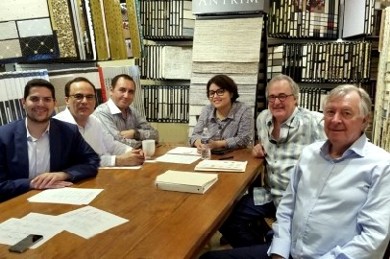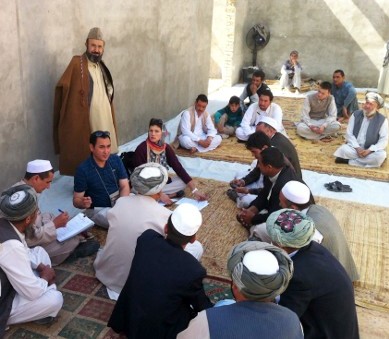KABUL CARPET EXPORT CENTER OPENS TO FACILITATE AFGHAN CARPET PURCHASES BY IMPORTERS

The Kabul Carpet Export Center management team meet in Charleston, S.C. From left, John Mattin, Assad Mattin, Alex Zahir, Najlla Habibyar, Rob Leahy and Richard Ringrose. Not pictured, Steve Landrigan. |
CHARLESTON, S.C. -- The U.S. Agency for International Development (USAID) has announced that it will provide funding to set up the Kabul Carpet Export Center (KCEC), a program designed to create jobs in Afghanistan by facilitating the purchase of area rugs by importers and wholesalers.
Plans for the KCEC were developed by carpet industry veterans Rob Leahy, Richard Ringrose, Alex Zahir and Stephen Landrigan working together as Impact Carpet Associates, LLC, headquartered in Charleston, S.C.
"Impact is the four partners that developed the KCEC project for USAID," explained Rob Leahy, project director, KCEC. "Basically it is a jobs creation program that stimulates employment for women and returning refugees."
Although the contract with USAID has just been signed, the four managers have already assembled a very good team of 20 people working in Kabul, according to Leahy. "The team is led by KCEC chief of party Najlla Habibyar, an Afghan woman who is well known in the carpet industry," he explained. "This team will be managing the project for us in Afghanistan, and we will travel there often to perform functional responsibilities."
In this exclusive Q&A, RugNews.com speaks with Leahy to determine how the program works, as well as its benefits to the Afghan people and the global area rug industry.

Center left, Alex Zahir discusses rug order with Afghan carpet manufacturers in Mazar-e Sharif, Afghanistan.
Who are the customers KCEC is targeting?
RL: Importers--We're focusing on importers and only importers because they have a [product] developmental mindset and are aware of the complexities of dealing with countries like Afghanistan or Pakistan.
How would you describe the benefits of the program?
RL: We're doing this for two really good reasons: first, it helps Afghanistan build equity in their own carpet business and country. That is an important feature of our program because most rugs woven in Afghanistan come through Pakistan.This helps the people of Afghanistan create equity in their own country. Number two is more of a rug industry reason: if the industry in Afghanistan doesn't continue, it will be yet another country that will have lost the beautiful craft that hand-knotted rugs are.
What are the services KCEC provides?
RL: For the first time, importers will have an organization in Afghanistan that will arrange for the wool, monitor the quality, inspect before shipment, and arrange for air freight at the lowest possible rate. We will finish and ship in Afghanistan rather than send the rugs to Pakistan as they might have been.
Don't get the wrong impression, many [rugs] will still be going to Pakistan - we are not trying to take business away from them. There is an incredible amount of weaving in Afghanistan: this program allows them to make rugs, finish and ship with a label that says Made in Afghanistan as opposed to an Afghan rug that is labeled Made in Pakistan.
Would you walk us through the process, please?
RL: The KCEC introduces a single point of contact for connecting international rug buyers with top carpet manufacturers in Afghanistan. It will help buyers place their orders, then monitor production through every stage. The KCEC's staff oversees communications between buyers and carpet manufacturers to eliminate any misunderstandings.
Through KCEC, and for the first time in Afghanistan, capital will be provided for carpet manufacturers to use in covering production costs. This will eliminate any delays in getting orders fulfilled.
Once a rug is completed and before it is exported, the KCEC will conduct a thorough inspection to ensure that it has been made to the buyer's specifications and meets the highest standards of Afghan carpet production. If any corrections or changes are needed, they will be completed before the rug leaves Afghanistan.
What about shipping?
RL: At our warehouse near the Hamid Karzai Kabul Airport, the KCEC will receive, inspect, and ship by air. They will facilitate the efficient processing of all Government of Afghanistan export formalities. Also, all paperwork needed for entry into the U.S. or other countries will be prepared in Kabul before the rug is shipped.
Carpets will be expertly packed and wrapped in high-grade material and on cardboard spools, ready to be displayed upon arrival. Carpets will be shipped via air freight on reliable carriers with the best possible rates.
Will the rugs be programmed?
RL: Programmed rugs require the same wool and the same dyestuff. These are craft rugs -- vegetable dyed, which are notoriously difficult to reproduce. So they won't be programmed, but importers will get continuing production of the same item. The importers will provide their own designs, which will remain unique to them and there will be continuity in the patterns and colors.
KCEC will be showing at Domotex 2019 with its own new booth and branding - a next-generation of the stand shown above in the Afghanistan Export Promotion Agency's exhibit at Domotex 2017 taken by RugNews.com.
Will KCEC be attending and exhibiting at trade shows?
RL: We're just starting, so we'll be attending the Rug Show New York later this month but not exhibiting. We'll be getting the information out, talking to potential customers. Going forward our strategy is to be at international trade shows where importers convene. We'll be at Domotex in January, and we'll be at their Shanghai show. China is a very important market for us.
Why China?
RL: The more affluent people in China want more of a Western look, and they consider tribal Afghan rugs Western in style. China has stopped making hand-knotted rugs; the government doesn't want them to. But they have a policy that if there is a need for something that isn't produced, the government doesn't mind importing. In fact, they give incentives for those products.
Are there vehicles to help importers with sell-through of their products to retailers and consumers?
RL: We will be advertising and promoting the products our importers buy, and using their names in the ads. This includes all people who fulfill the role of bringing products to the retailers. Communications to retailers will be from the point of view that a particular importer has committed to helping the people of Afghanistan and that USAID commends the the retailer and consumer for buying their products. We'll also provide pictures of the rugs and how they are made.
What was the catalyst for your own commitment to Afghanistan?
RL: The catalyst was a meeting in Washington, D.C. in 2007. I met with some people who were putting together a project to help the Afghans, and they asked me to go on a trade mission with them to talk about rugs. My first trip to Afghanistan was in 2007 with them, and I've been hooked ever since -- hooked on trying to figure out how to help the Aghans build equity in their own industry and their people. USAID is all about people, but we're focusing on the the rug industry as well. I go once or twice a year; I've been back 10 to 12 times now, and I'm going back next week.
Rob Leahy (far right) in Dehdadi, Aafghanistan